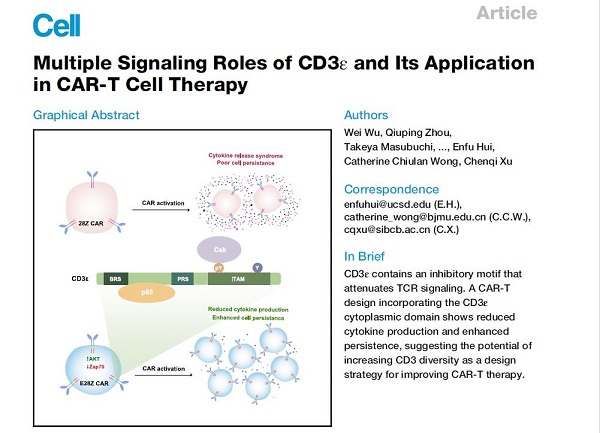T cells are natural warriors to fight against tumor cells in human body. The major receptor responsible for tumor antigen recognition in T cells is the T cell receptor (TCR). However, not all TCRs recognize tumor antigens.
By means of genetic engineering, T cells are equipped with chimeric antigen receptor (CAR) to specifically recognize tumor antigen and kill tumor cells in human body. CAR-T cell therapy has achieved unprecedented success in treating B cell malignancy. Now, CAR-T cell therapy is facing major clinical challenges including cytokine release syndrome and poor persistence.
In a study published online in Cell on July 29, a research team led by Prof. XU Chenqi from the Center for Excellence in Molecular Cell Science, Shanghai Institute of Biochemistry and Cell Biology of the Chinese Academy of Sciences, Prof. HUANG Chaolan from Peking University Health Science Center, and Prof. HUI Enfu from University of California, San Diego, developed a new strategy of CAR-T cell therapy based on new understanding of TCR signal transduction.
The researchers have been studying T cell biology for more than a decade. Their earlier works unraveled new regulatory mechanisms of TCR and PD-1, and led to the development of new means of cancer immunotherapy.
In this study, by using immunological, mass spectrometric, biochemical and biophysical techniques, the researchers revealed new signaling roles CD3e, a key signaling subunit of TCR.
They found that CD3e could recruit inhibitory signaling molecule Csk via its mono-phosphorylated ITAM motif and could also recruit stimulatory molecule PI3K via its BRS motif. When CD3e was incorporated into the clinically used 28Z CAR, E28Z CAR-T cells had reduced cytokine production and enhanced cell persistence. In the preclinical animal models, E28Z CAR-T cells showed better anti-tumor function compared to 28Z CAR-T cells.
At present, this study is based on mouse models. The researchers will continue to explore its promising translational potentials in treating blood and solid malignancies.

Contact: cqxu@sibcb.ac.cn
Reference: https://www.cell.com/cell/fulltext/S0092-8674(20)30883-7

 Appendix:
Appendix: